McKees Rocks, PA, a borough nestled where Chartiers Creek meets the Ohio River, was once home to a significant prehistoric landmark: McKees Rocks Mound. This impressive earthwork, the largest of its kind in Western Pennsylvania, stood as a silent testament to the region’s rich Native American history. While time and development have erased this physical monument, its story, unearthed through archaeological investigation, continues to resonate, offering valuable insights into the ancient cultures that once thrived in what is now McKees Rocks, PA.
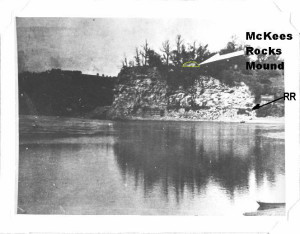 Location of McKees Rocks Mound on the bluff overlooking the mouth of Chartiers Creek with the Ohio River in the foreground. This photograph was taken in 1896 and is used courtesy of the Section of Anthropology of Carnegie Museum of Natural History. It was taken from either from a boat or Brunot’s Island in the Ohio River. The white arrow was added by the excavators. There is a train track at the base of the bluff. The author added the mound outline, dark arrow pointing to the railroad line and mound label.
Location of McKees Rocks Mound on the bluff overlooking the mouth of Chartiers Creek with the Ohio River in the foreground. This photograph was taken in 1896 and is used courtesy of the Section of Anthropology of Carnegie Museum of Natural History. It was taken from either from a boat or Brunot’s Island in the Ohio River. The white arrow was added by the excavators. There is a train track at the base of the bluff. The author added the mound outline, dark arrow pointing to the railroad line and mound label.
The Discovery and Description of McKees Rocks Mound
In the 19th century, McKees Rocks Mound was a well-known feature of the landscape. Rising 16 feet high with a basal diameter of 85 feet, it dominated the bluff overlooking the confluence of Chartiers Creek and the Ohio River. Its prominent location in McKees Rocks made it a subject of local curiosity and eventually, scientific interest. Before its excavation, the mound stood as an imposing reminder of the long history of human presence in the area.
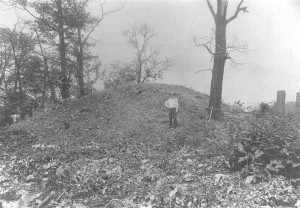 McKees Rocks Mound prior to excavation in 1896. Photograph is courtesy of the Section of Anthropology of Carnegie Museum of Natural History.
McKees Rocks Mound prior to excavation in 1896. Photograph is courtesy of the Section of Anthropology of Carnegie Museum of Natural History.
The 1896 Excavation by the Carnegie Museum of Natural History
The burgeoning field of archaeology in the late 19th century brought McKees Rocks Mound into the scientific spotlight. The newly established Carnegie Museum of Natural History recognized the mound’s potential significance and chose it as their first archaeological excavation site in 1896. Under the direction of Frank M. Gerrodette, the museum undertook the ambitious task of uncovering the secrets held within this ancient structure located in McKees Rocks. Gerrodette’s work, though pioneering for its time, predated many modern archaeological techniques, including radiocarbon dating and a fully developed understanding of the local prehistoric timeline. His initial excavation focused on only half of the mound, but it provided crucial preliminary insights.
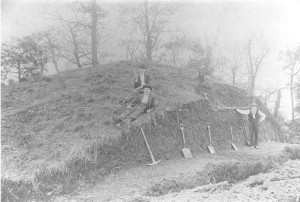 McKees Rocks Mound during the 1896 excavation by Gerrodette. Photograph is courtesy of the Section of Anthropology of Carnegie Museum of Natural History.
McKees Rocks Mound during the 1896 excavation by Gerrodette. Photograph is courtesy of the Section of Anthropology of Carnegie Museum of Natural History.
Findings from the Excavation: Adena and Woodland Periods
Gerrodette’s excavation revealed that McKees Rocks Mound was not a single-event construction, but rather the result of three distinct mound-building episodes. Later analysis of the artifacts recovered by Gerrodette, conducted by subsequent archaeologists, refined the timeline of the mound’s construction. The first two phases were attributed to the Early Woodland period (500 B.C. to A.D. 100), associated with the Adena culture or Cresap phase Adena groups. These early stages raised the mound to approximately 15 feet. The final phase of mound building was linked to the Middle Woodland period (A.D. 100-1000), based on the discovery of pottery with limestone temper, a hallmark of this period. These findings established McKees Rocks Mound as a site used over centuries by different prehistoric cultures in the McKees Rocks region.
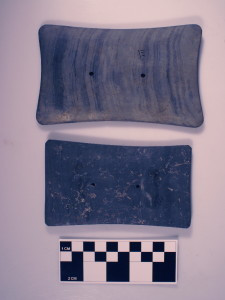 Gorgets placed with the important Early Woodland burials at McKees Rocks Mound. The bottom gorget was placed with the central burial in the earliest portion of the mound; while the upper gorget was placed with the central burial in the second mound stage. Photograph by the author. Collection access courtesy of the Section of Anthropology of Carnegie Museum of Natural History.
Gorgets placed with the important Early Woodland burials at McKees Rocks Mound. The bottom gorget was placed with the central burial in the earliest portion of the mound; while the upper gorget was placed with the central burial in the second mound stage. Photograph by the author. Collection access courtesy of the Section of Anthropology of Carnegie Museum of Natural History.
Key Artifacts Unearthed from McKees Rocks Mound
The burials within McKees Rocks Mound yielded a fascinating array of artifacts, providing glimpses into the beliefs and practices of the people who built it. The earliest section of the mound contained a single burial, identified as Early Woodland, accompanied by a gorget (a possible status symbol), a grooved adze, a copper imitation bear canine wrapped in twined fabric, and hundreds of shell beads. The presence of copper, likely sourced from the Great Lakes region, and marine shells from the Atlantic coast, highlights the extensive trade networks or far-reaching journeys of these early inhabitants of the McKees Rocks area.
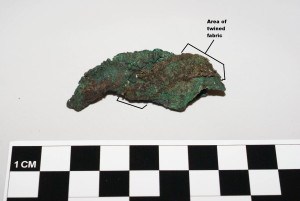 Imitation bear canine with twined fabric adhering to it that was found with the central burial from the earliest section of the mound. Photograph by the author. Collection access courtesy of the Section of Anthropology of Carnegie Museum of Natural History.
Imitation bear canine with twined fabric adhering to it that was found with the central burial from the earliest section of the mound. Photograph by the author. Collection access courtesy of the Section of Anthropology of Carnegie Museum of Natural History.
The second Early Woodland mound stage contained two burials, one with another gorget. The final, Middle Woodland stage, held thirty burials, including one with freshwater pearl beads and others with pottery fragments. Re-examination of the pottery later revealed it to be shell-tempered, characteristic of the Late Woodland or Late Prehistoric period (A.D. 1000-1550), suggesting continued use of the mound site even later than initially thought.
The Pennsylvania Historical Marker: Remembering McKees Rocks Mound
While the physical mound is gone, its historical significance is officially recognized. On May 18, 2002, a Pennsylvania Historical Marker was erected in a park near the mound’s original location in McKees Rocks. The marker commemorates “Largest Native American burial mound in Western PA.” and details its construction by the Adena people and later use by other cultures. Although some of the marker’s dating is now considered slightly outdated by current archaeological understanding, it serves as a vital public reminder of the rich Native American heritage of McKees Rocks, PA.
Loss and Legacy of McKees Rocks Mound
Despite its historical importance, McKees Rocks Mound suffered a tragic fate in the 20th century. Quarrying operations on the bluff, likely to obtain stone for road construction in McKees Rocks, led to the complete destruction of the mound. Later, a cement plant was built at the base of the bluff, further altering the landscape. A 2008 visit by Seneca Nation representatives and archaeologists confirmed the complete obliteration of the mound. Today, visitors to McKees Rocks can see the area where the mound once stood, but no trace of the monument remains.
 Cut bluff where rock was quarried sometime during the 20th century.
Cut bluff where rock was quarried sometime during the 20th century.
The loss of McKees Rocks Mound is a poignant reminder of the vulnerability of archaeological sites to development. However, the early excavation by Gerrodette and subsequent research have preserved valuable knowledge about this significant site and the people who created it. The story of McKees Rocks Mound stands as an important chapter in the history of McKees Rocks, PA, and Western Pennsylvania, urging us to appreciate and protect the remaining traces of our shared past.
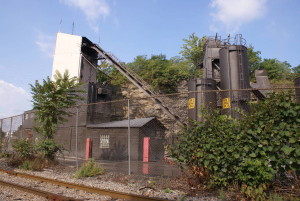 Cement company now at the base of the quarried out bluff. Note the train tracks in front of it – these are the railroad tracks (still in use) that show up in Figure 1.
Cement company now at the base of the quarried out bluff. Note the train tracks in front of it – these are the railroad tracks (still in use) that show up in Figure 1.
References for the Excavation of McKees Rocks Mound
Carpenter, E. S.
1949 The Ancient Mounds of Pennsylvania, Vol. 1 and 2. on file at the Section of Archaeology, The State Museum of Pennsylvania, Harrisburg.
1951 Tumuli in Southwestern Pennsylvania. American Antiquity 16(4):329-346.
Dragoo, D. W.
1963 Mounds for the Dead: an Analysis of the Adena Culture. Annals of Carnegie Museum Vol. 37, Pittsburgh, Pennsylvania.
McMichael, E. V.
1956 An Analysis of McKees Rocks Mound, Allegheny County, Pennsylvania. Pennsylvania Archaeologist 26(3-4):128-151.
Swauger, James L.
1940 A review of F. H. Gerodette’s Notes on the Excavtion of McKees Rocks Mound. Pennsylvania Archaeologist 20(1):8-10.
